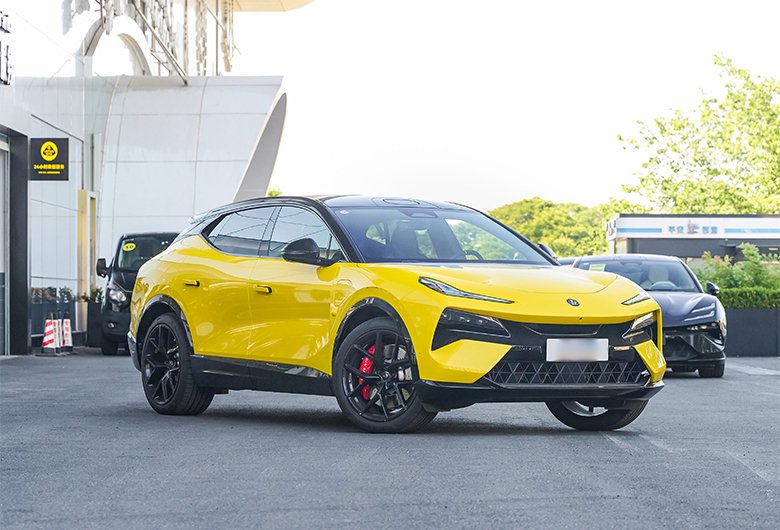
Description
- APPEARANCE
- INTERIOR
- SEAT SPACE
- DETAILS
From an overall visual point of view, Eletre presents a sense of lightness, more like a sports car with a slightly higher chassis than a traditional SUV. This "flying in the wind" design approach is consistent with the design of Evija and Emira Inspiration comes from the same source.
Following the "porous" principle of Emira and Evija, Eletre adopts a unique design idea in the aluminum body. The most obvious pore design is located on the front edge of the car body, which can effectively guide the airflow. Multiple aperture designs can be seen behind the front wheel arches, behind the rear wheels, and even on the top of the D-pillar.
From a driving perspective, the advantages of the pore design are self-evident. It reduces the resistance encountered by the car body when cutting through the air, effectively improves endurance, vehicle speed and performance, and brings a more efficient driving experience.
In order to guide air through the body more quickly, Eletre is equipped with a continuously variable active air intake grille. The lines of the triangular lotus petals are designed to be interconnected to form a matrix arrangement, occupying the center position. It is worth mentioning that the design of this air intake grille is exquisite and complex. It remains closed when the vehicle is stationary or driving and needs to reduce resistance. When the motor, battery pack and braking system need to be cooled, it is closed in a unique way. Open to draw air into the radiator.
The advantage of this is that it cleverly resolves the paradox of high wind resistance in electric vehicles without air intake grilles, and at the same time meets the heat dissipation needs of the motor battery.
On Eletre, it is not uncommon to design service functions. For example, the hood seems a bit inconsistent. Although this car is not equipped with a gasoline engine, Ben Payne's team still reserved a unique "bonnet area" for the new car, which is also a tribute to Lotus's glory in the fuel era. However, Ben Payne gave this hood an actual aerodynamic function: there are two "air ducts" on the front hood of the Eletre that are not pure electric models. They extend from the front edge of the car body, and the airflow can Through this "air channel" it flows out of the car body, reducing resistance and effectively guiding the airflow.
Due to the full carbon roof of the vehicle, the height of the Eletre's body has been significantly reduced visually, making the vehicle more dynamic. Among them, the main body of the rear of the car is composed of a unique floating split spoiler made of carbon fiber. It is inspired by racing cars and looks like a small rectifying wing of a racing car. After optimizing the aerodynamic angle, the roof spoiler directs the airflow under the glass, allowing the airflow to flow into the active rear wing. The rear wing can also automatically deploy when driving at high speeds, and provides three different deployment angles according to the driving mode selection.
All the above exterior designs are enough to show that the Eletre body follows the design philosophy of past Lotus products in countless details, and at the same time inherits Lotus' unique technical advantages: aerodynamics-"controlling the wind with design."
To a certain extent, Eletre has merged Lotus’ tradition with the future – trying to “further tame the wind with design and electric power.” This fusion of past and present is also deeply reflected in Eletre’s interior design. From the overall look and feel, Eletre breaks away from the slightly plain design of traditional Lotus products and uses a large number of soft materials to achieve the perfect combination of decorative design art and functional luxury. Eletre uses extensive use of man-made microfibers and advanced wool blended fabrics, which are 50% lighter than traditional leather, allowing soft coverage of all areas that users can touch, creating a unique and luxurious texture. In addition, the stylized “marble finish” carbon fiber is made from recycled trim with woven edges, adding to Lotus’ environmental philosophy in addition to technology.
Inside Eletre, most people’s eyes will be attracted by a huge 15.1-inch 4KOLED screen. In addition to regular entertainment activities, Lotus has unified 95% of car functions on this screen. Users can access it within three touches on the screen through a new user interface. In addition, the rear seats of Eletre are also equipped with high-definition screens. The touch-screen layout of a large number of functions reduces the use of buttons, allowing the entire vehicle to eliminate complexity and simplify the interior design, presenting unique technological attributes. This concept is also reflected in the assembly process of lidar.
Eletre’s flippable lidar sensor is the world’s first mass-produced flippable lidar. This reversible lidar is hidden when not in use, and only emerges from the top of the windshield and front wheel arch when needed. The sensor behind the car is fixed to the top of the trunk lid. When not in use, the flip-up lidar can effectively reduce the wind resistance of the entire vehicle while maintaining the beauty of the overall design. This is also highly consistent with Lotus' philosophy of pursuing ultimate wind resistance and simplifying complexity.
Streamline where it should be streamlined, and never be ambiguous where users should expect it.
In addition to lidar, Eletre is also equipped with ultra-high-definition cameras, 4D millimeter-wave radar and other hardware. Combined with two 8155 chips, its overall computing power reaches 2.2 GFLOPS, and the software and hardware can support L3 level autonomous driving. This is the first product among the current ultra-luxury brand electric SUVs to clearly announce that it can support L3 autonomous driving.
In addition, Lotus has implemented round-the-clock OTA software upgrade service on Eletre. The new car applies brand-new interconnection technology and is compatible with 5G communication technology, enabling real-time interconnection. Therefore, users can connect to the vehicle through the smartphone APP, update the software at any time through OTA, and purchase and set up the latest features through the software in a timely manner. This also pioneered the ultra-luxury brand electric SUV.
Eletre is equipped with the industry's top 800V electrical architecture, which is mainly composed of aluminum and high-strength steel, giving full play to excellent structural rigidity. The new car is equipped with dual motors to drive the front and rear wheels respectively. Each drive motor is integrated with a controller and reducer, forming a three-in-one electric drive system with a maximum output of 600 horsepower. This efficient design is very classic Lotus The unique method makes the electric drive system smaller and lighter. With a charging power of 350kW, the battery can travel 400 kilometers in 20 minutes, and the battery can travel more than 600 kilometers when fully loaded. In the era of fuel vehicles, Lotus could run in F1 without building an engine, and Lotus wrote a track legend; in the era of electric vehicles, with its leading three-electric system and unique aerodynamic reserves, Eletre redefined what a new era is. The ultra-luxury brand electric SUV also allows Lotus' past characteristics to be infinitely magnified.
Inquiry
ELETRE
| Model: | LOTUS ELETRE |
| 0-100km/H: | 4.5 |
| CLTC (KM): | 650 |
| L-W-H (mm): | 5103*2019*1636 |
| Drive Type: | Electric Car |
Inquiry Now































